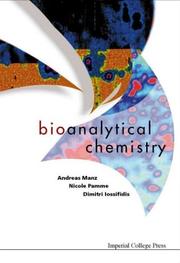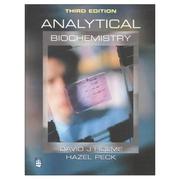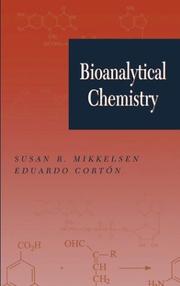| Listing 1 - 10 of 42 | << page >> |
Sort by
|

ISBN: 9781860943713 1860943713 1860943705 Year: 2004 Publisher: London : Singapore : Imperial College Press ; Distributed by World Scientific Pub.,
Abstract | Keywords | Export | Availability | Bookmark
 Loading...
Loading...Choose an application
- Reference Manager
- EndNote
- RefWorks (Direct export to RefWorks)
Chemistry, Analytical. --- Sequence Analysis. --- Analytical biochemistry. --- Biochimie analytique --- Analytical biochemistry
Book
Year: 1875 Publisher: Paris : C. Reinwald,
Abstract | Keywords | Export | Availability | Bookmark
 Loading...
Loading...Choose an application
- Reference Manager
- EndNote
- RefWorks (Direct export to RefWorks)
Physiological chemistry --- Analytical biochemistry --- Analytical chemistry. --- Biochimie analytique --- Chimie analytique

ISBN: 058229438X Year: 1998 Publisher: Harlow Prentice Hall
Abstract | Keywords | Export | Availability | Bookmark
 Loading...
Loading...Choose an application
- Reference Manager
- EndNote
- RefWorks (Direct export to RefWorks)
biochemie --- General biochemistry --- Analytical biochemistry --- biologie --- Biochimie analytique --- Analytical biochemistry. --- Analytische biochemie --- 577

ISBN: 0471544477 Year: 2004 Publisher: London ; New York, NY : Wiley-Interscience,
Abstract | Keywords | Export | Availability | Bookmark
 Loading...
Loading...Choose an application
- Reference Manager
- EndNote
- RefWorks (Direct export to RefWorks)
General biochemistry --- biochemie --- biosensoren --- biochemistry --- analytische chemie --- Analytical biochemistry --- Analytical biochemistry. --- Chemistry, Analytical. --- Biochimie analytique
Book
ISBN: 3540129375 0387129375 Year: 1988 Publisher: Berlin : Springer-Verlag,
Abstract | Keywords | Export | Availability | Bookmark
 Loading...
Loading...Choose an application
- Reference Manager
- EndNote
- RefWorks (Direct export to RefWorks)
Thermal analysis methods have been introduced into forensic sciences only in recent times. Though thermoanalytical instruments have been available commercially for some decades it was not until the beginning of the seventies that forensic scientists became interested in them. At that time some state forensic science laboratories in the Federal Republic of Germany made use of differential thermal analysis for forensic soil investigations. The forensic science section of the city police of ZUrich, Switzerland, applied an instrument (differential thermal analysis and thermogravimetry) for various purposes. Investigations of fibers by means of differential scanning calorimetry were reported by the Centre of Forensic Sciences at Toronto, Canada, and on the characterization of candle-waxes by differential thermal analysis by the Metropolitan Police Forensic Science Laboratory, London, England. Later on some other insti tutions like the Bundeskriminalamt at Wiesbaden, Germany, or the Home Office Central Research Establishment at Aldermaston, England, purchased instruments for one or more of the following thermal analysis methods: differential thermal analysis or differential scanning calorimetry, thermogravimetry, and thermomechanical analysis. . But even now thermoanalytical instruments are not widespread in forensic science institutes and knowledge of their forensic potential seems to be limited. In the following chapters we will give a survey of the most important thermal analysis methods mentioned above, and on current forensic applications and/or fields of actual research efforts.
Chemistry, Forensic. --- Forensic sciences. --- Analytical biochemistry. --- Chimie légale. --- Criminalistique. --- Biochimie analytique
Book
ISBN: 9781071624555 9781071624531 9781071624753 9781071624739 Year: 2023 Publisher: New York, NY : Humana,
Abstract | Keywords | Export | Availability | Bookmark
 Loading...
Loading...Choose an application
- Reference Manager
- EndNote
- RefWorks (Direct export to RefWorks)
This detailed collection explores recent advances in molecular imaging techniques involving bioluminescence, currently employed in biolaboratories around the world. Volume 2 delves into techniques for heterogeneous conjugates, protein fragment-complementation assays, BRET-based imaging, as well as instrumentation and software. Written for the highly successful Methods in Molecular Biology series, chapters include introductions to their respective topics, lists of the necessary materials and reagents, step-by-step, readily reproducible laboratory protocols, and tips on troubleshooting and avoiding known pitfalls. Authoritative and comprehensive, Bioluminescence: Methods and Protocols, Fourth Edition, Volume 2 presents practical guidance for researchers and technical staff on how to proceed with bioluminescence studies in their laboratories.
Bioluminescence. --- Bioluminescence assay. --- Chemiluminescence. --- Analytical biochemistry. --- Molecular Imaging. --- Chimiluminescence. --- Imagerie moléculaire. --- Biochimie analytique.
Book
ISBN: 354053203X 038753203X Year: 1991 Publisher: Berlin : Springer-Verlag,
Abstract | Keywords | Export | Availability | Bookmark
 Loading...
Loading...Choose an application
- Reference Manager
- EndNote
- RefWorks (Direct export to RefWorks)
The range at which a weapon has been fired is an important measurement for the reconstruction of firearms offenses (murder, suicide, accident). All changes caused by a shot and which vary according to the distance from the weapon are suitable in principle for determining this distance. However, some procedures are very elegant in theory but hardly applicable in practice. The constructions of ammunition and the sequence of events during a shot are dealt with first as this knowledge forms a basis for understanding the various methods. The individual zones (classes) of firing distances (contact shot, intermediate shot, distance shot) are described. In this connection, the morphological methods for determining the firing distance are discussed. From the shape and size of the powder residue distribution (soot stains, powder tattooing) and with the knowledge of the weapon and ammunition, the distance from the target can be elucidated. In this chapter, the methods of making an invisible distribution visible are also dealt with. In order to determine the range of the shot from the appearance of the wound no complicated apparatus is necessary. One can judge with the naked eye. These procedures have a great advantage over the methods discussed in the following chapter in that they give stronger proof. They are more vivid and convincing for the uninitiated (judge or jury) than abstract measurements obtained by scientific devices.
Chemistry, Forensic. --- Forensic entomology. --- Analytical biochemistry. --- Forensic sciences --- Chimie légale --- Entomologie légale --- Biochimie analytique --- Criminalistique --- Laboratories. --- Laboratoires
Book
ISBN: 3540184473 0387184473 Year: 1988 Publisher: Berlin : Springer-Verlag,
Abstract | Keywords | Export | Availability | Bookmark
 Loading...
Loading...Choose an application
- Reference Manager
- EndNote
- RefWorks (Direct export to RefWorks)
Competitive binding techniques such as radioimmunoassay (RIA) are widely used to measure an enormous variety of compounds in biological fluids. Current methods have 1 2 arisen from the pioneering work ofYalow and Berson in the U. S. A. and Ekins in the u. K. Much of the early development was concerned with the analysis of protein hormones, and nearly a decade passed before attention focussed also on small molecules such as steroids and drugs. The potential of immunoassay methods for drug monitoring in clinical and forensic laboratories and in addict treatment programmes resulted in the commercial production of immunoassays for various therapeutic and abused drugs, making the technique available to laboratories lacking the facilities to raise their own antisera and synthesise labelled compounds. However, commercial assays are not only expensive but are restricted in range, and so it is advantageous for a forensic laboratory to have the capability to devise "in-house" immunoassays suited to its particular requirements. This chapter describes the theory and practice of RIA in forensic drug analysis. Much of the theory and some of the practice are applicable to immunoassays in which non isotopic labels are used, but such assays are not described in detail since, to date, the versatility and sensitivity of RIA have made it the immunoassay technique of choice in forensic toxicology. The particular advantages of RIA are its sensitivity and the fact that samples such as haemolysed blood can be assayed with little or no prior preparation.
Criminalistique. --- Chimie légale --- Biochimie analytique. --- Empreintes digitales. --- Dosage radioimmunologique. --- Forensic sciences. --- Chemistry, Forensic. --- Analytical biochemistry. --- Fingerprints. --- Radioimmunoassay.
Book
ISSN: 07246145 ISBN: 9783642123627 9783642123610 9783642128523 3642128521 3642123619 Year: 2010 Volume: 117-118 Publisher: Berlin Heidelberg Springer Berlin Heidelberg Imprint Springer
Abstract | Keywords | Export | Availability | Bookmark
 Loading...
Loading...Choose an application
- Reference Manager
- EndNote
- RefWorks (Direct export to RefWorks)
Reporter cells: - Yeast Based Sensors by Mifumi Shimomura-Shimizu and Isao Karube - Mammalian Cell-Based Sensor Systems by Pratik Banerjee, Briana Franz, and Arun K. Bhunia - Fluorescent and Bioluminescent Cell-Based Sensors: Strategies for Their Preservation by Amol Date, Patrizia Pasini, and Sylvia Daunert - Electrochemical Cell-Based Sensors by Eliora Z. Ron and Judith Rishpon - Microbial Cell Arrays by Tal Elad, Jin Hyung Lee, Man Bock Gu, and Shimshon Belkin Devices: - Surface Functionalization for Protein and Cell Patterning by Pascal Colpo , Ana Ruiz , Laura Ceriotti , and François Rossi - Fiber-Optic Based Cell Sensors by Evgeni Eltzov and Robert S. Marks - Electronic Interfacing with Living Cells by James T. Fleming - On-Chip Detection of Cellular Activity by R. Almog , R. Daniel , S. Vernick , A. Ron , H. Ben-Yoav, and Y. Shacham-Diamand
Chemistry. --- Biotechnology. --- Cell Biology. --- Biological Techniques. --- Analytical Chemistry. --- Analytical biochemistry. --- Cytology. --- Cytology --- Chimie --- Biochimie analytique --- Biotechnologie --- Cytologie --- Research_xMethodology. --- Biosensors --- Cells
Book
ISBN: 354051841X 038751841X Year: 1990 Publisher: Berlin : Springer-Verlag,
Abstract | Keywords | Export | Availability | Bookmark
 Loading...
Loading...Choose an application
- Reference Manager
- EndNote
- RefWorks (Direct export to RefWorks)
Methamphetamine is one of the most widely abused stimulants and together with amphetamine has led to serious social problems. Numerous papers in the fields of medicine, toxicology, pharmacology, sociology, etc. have appeared. In Japan for example about 20,000 to 22,000 persons have been arrested in recent years on suspicion of abuse, smuggling or illegal manufacture of drugs. In other countries, stimulant drugs also present social problems and efforts have been directed toward prevention. Although marked development of analytical techniques in the field of forensic sciences has been achieved, there is a need for a continuous review of recent advances. A review of studies on methamphetamine has therefore been made from the standpoint of forensic toxicology and legal medicine. Attention has been directed to biological samples because analyses and interpretation for the purpose of t.oxicological and As a detailed survey on abuse drugs involving clinical practice are important. 1 methamphetamine and amphetamine has been made by Fishbein and covered the time before 1980, we refer only to data and events appearing after 1980.
Chemistry, Forensic. --- Forensic sciences. --- Forensic toxicology. --- Analytical biochemistry. --- Chimie légale --- Criminalistique. --- Toxicologie légale --- Biochimie analytique. --- Chimie légale --- Toxicologie légale
| Listing 1 - 10 of 42 | << page >> |
Sort by
|

 Search
Search Feedback
Feedback About UniCat
About UniCat  Help
Help News
News